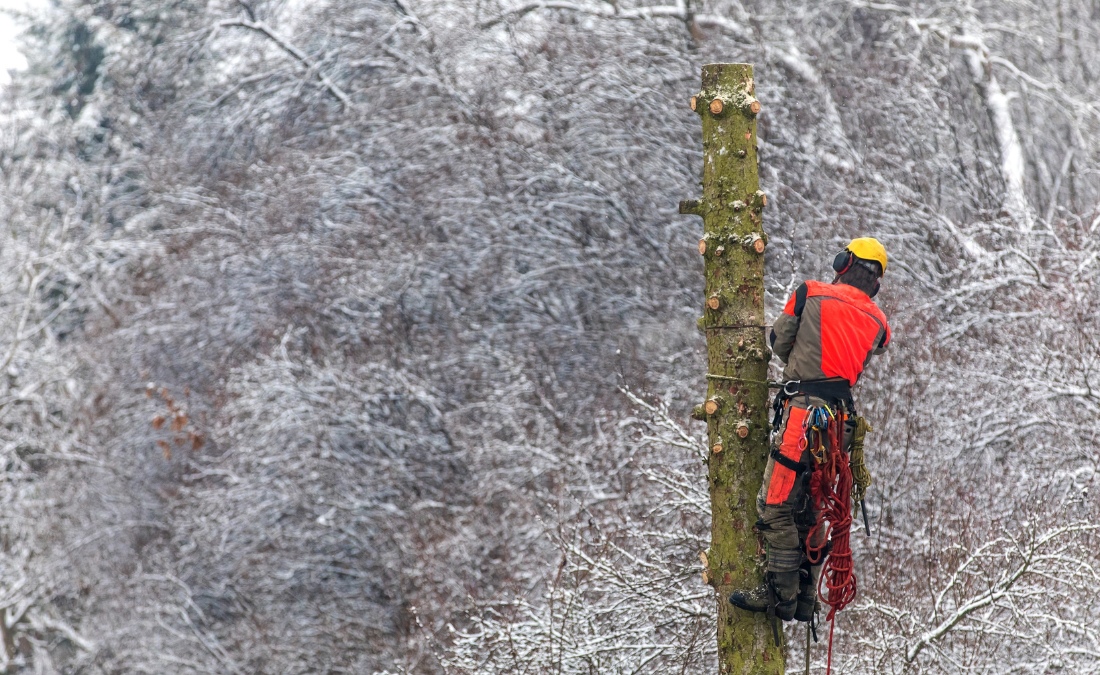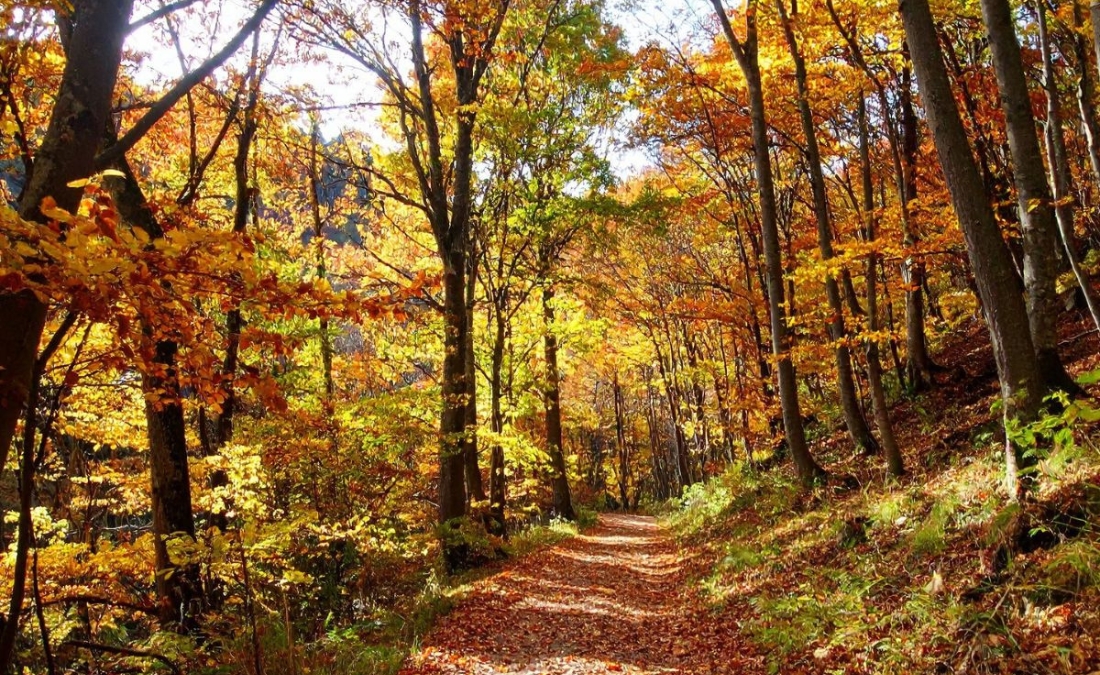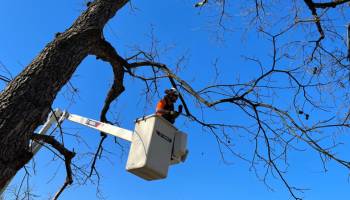4 Reasons Why Arborists Recommend Winter Tree Pruning for Kansas City Trees
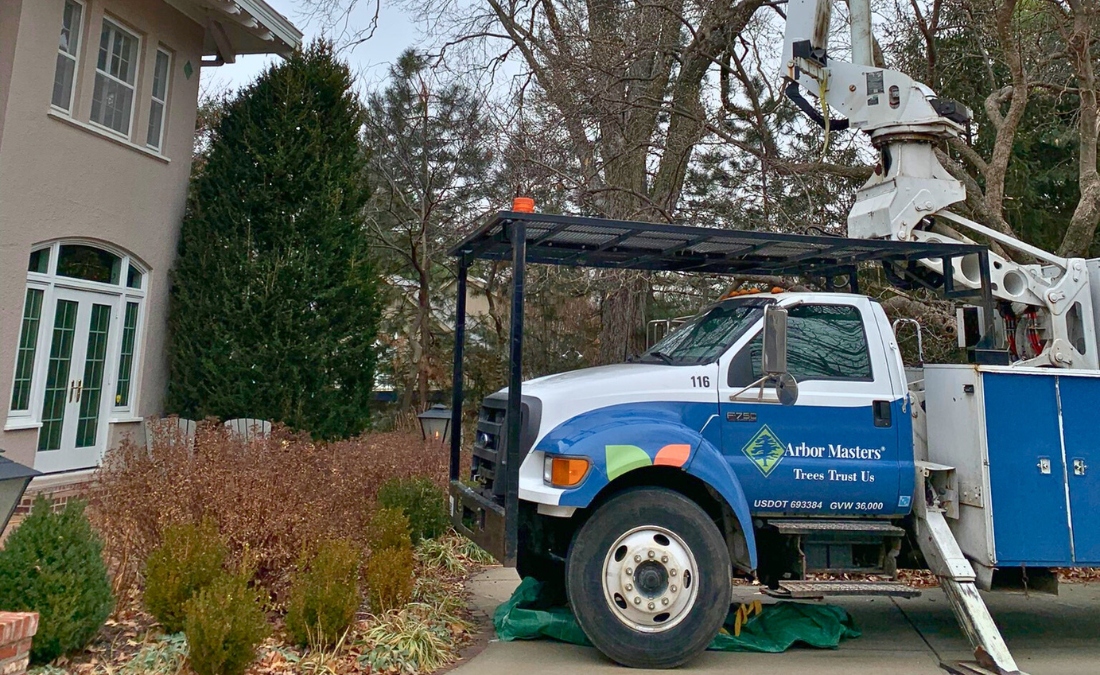
Arborists agree: winter pruning in Kansas City is essential for healthy, storm-ready trees. Find out when and why timing makes all the difference.
Winter tree pruning in Kansas City isn’t just a convenient off-season activity. It’s scientifically the best time to prune most tree species in Johnson County, particularly the valuable oaks, maples, and elms common throughout areas like Overland Park, Shawnee, and Leawood.
Key Takeaways
- Winter dormancy allows ISA Certified Arborists to make precise cuts with minimal stress to trees, resulting in faster wound closure and vigorous spring growth in Johnson County landscapes.
- Oak and elm trees must be pruned exclusively during winter months in Kansas to prevent deadly oak wilt and Dutch elm disease transmission when beetles are dormant.
- Dormant season pruning removes weak, damaged, and hazardous branches before ice and snow loads can cause dangerous breakage in Overland Park, Shawnee, and Leawood properties.
- Clear structural view without foliage enables professional arborists to identify crossed limbs, co-dominant stems, and disease symptoms that threaten tree stability.
- December through early March provides the ideal pruning window for most Kansas City trees, protecting both tree health and property values.
- Professional winter pruning strengthens trees against the unpredictable storm patterns that increasingly threaten Southwest Kansas City metro homes.
Why Is Winter the Best Time to Prune Trees in Kansas City?
Winter is the best time to prune trees in Kansas City because that’s the time of year when they enter dormancy. During winter dormancy, trees react very differently to pruning cuts than they do in active growth, making this season scientifically superior for most tree species in Johnson County.
The physiological state of dormancy fundamentally changes how trees respond to pruning cuts. During winter months, trees conserve energy, heal wounds faster, and face zero risk from disease-carrying beetles that threaten oaks and elms during warmer seasons. For homeowners protecting property values and tree health in Southwest Kansas City, understanding why December through early March provides the ideal pruning window prevents costly mistakes and ensures decades of vigorous tree growth.
1. Dormant Trees Heal Better and Experience Less Stress from Pruning
In winter dormancy, a tree’s growth processes slow almost to a stop, reducing stress from pruning for several reasons:
- Minimal Sap Flow: Trees stop actively transporting water and nutrients, so your Overland Park and Leawood trees lose far less energy when cut during dormancy.
- Stored Energy Reserves: Carbohydrates (a tree’s primary energy source) stay locked in the root system all winter, unused until spring growth resumes.
- No Growth Competition: Trees pruned in dormancy direct all stored energy toward wound healing rather than supporting active foliage.
- Focused Compartmentalization: Coming out of dormancy, trees prioritize wound sealing before channeling energy into strong, directed growth.
Unlike humans, trees don’t repair damaged tissue – they wall it off. Winter conditions give them the best environment to start that protective process quickly and effectively. Cold temperatures inhibit fungi and bacteria, giving trees weeks to establish defenses before spring’s energy-intensive growth flush begins.
For mature oaks and maples in areas like Mission Hills and Prairie Village, conserving energy is especially important. Their large pruning cuts demand more resources, and doing this work in winter ensures energy isn’t diverted from vital healing.
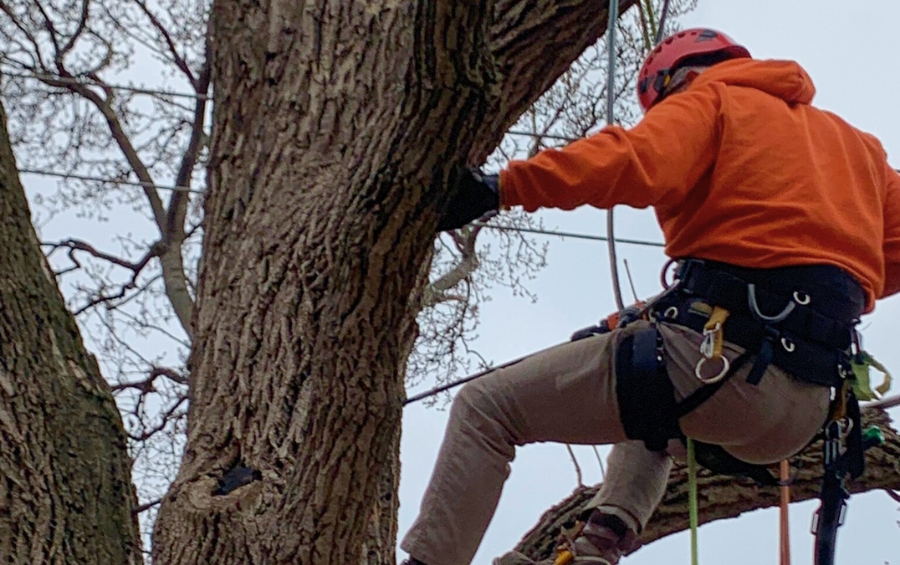
Winter tree pruning in Overland Park keeps large shade trees healthy, safe, and storm-ready.
2. Winter Pruning Prevents Oak Wilt and Dutch Elm Disease in Kansas
Oak wilt kills millions of oaks across the U.S., and in Kansas, red oak species are especially vulnerable.
Sap beetles spread the disease when temperatures rise above 50°F, typically from April through July in Kansas City. A single pruning cut in May can infect an entire neighborhood of oaks through interconnected root systems. The only completely safe window to prune is December through early March, when beetles remain dormant.
European elm bark beetles spread Dutch elm disease in the same way: by feeding on fresh pruning wounds during warmer months. They remain active from April through September in Kansas, drawn to sap that flows from newly cut branches. Pruning between December and March allows wounds to compartmentalize before beetles reemerge in spring, reducing the risk of infection.
For established oaks and elms in communities like Overland Park, Prairie Village, Shawnee, and Olathe, this winter-only schedule isn’t optional; it’s the difference between thriving trees and dead ones.
3. Winter Provides the Clearest Structural View for Safer Tree Pruning
Winter’s leafless conditions reveal structural problems invisible during the growing season. ISA Certified Arborists can identify and address:
- Crossed or Rubbing Branches: These create wounds that invite disease and weaken tree structure.
- Co-Dominant Stems: Two leaders of similar size with weak connections that split catastrophically under ice load or high winds.
- Dead Wood: Brittle dead branches that become dangerous projectiles during Kansas City storms.
- Disease Symptoms: Cankers, decay, and other issues hiding in bark crevices become visible without foliage.
This clear view enables precise cut placement at branch collars for optimal wound closure and allows arborists to make strategic decisions about which branches to remove for long-term tree health.
4. Winter Tree Pruning Reduces Storm Damage Risk in Kansas City
The January and March 2025 winter storms demonstrated what Kansas City homeowners already know: our region experiences unpredictable and often severe winter weather. Proactive winter pruning is your best defense against the tree damage these storms can cause.
What Winter Pruning Removes to Prevent Storm Breakage
Every mature tree in communities across Southwest Kansas City accumulates structural weaknesses over time that become failure points during storms:
- Deadwood: Brittle dead branches become dangerous under ice load; inches of snow add hundreds of pounds to canopies.
- Co-Dominant Stems: Because of their generally weak connection point, co-dominant stems are liable to split under ice load or high winds, often destroying half the tree when they split.
- Excess Weight: Selective canopy thinning reduces snow and ice surface area, preventing top-heavy failures.
How Winter Structural Pruning Prepares Trees for High Wind Events
The March 2025 storm pummeled Johnson County with 60-mile-per-hour winds, showing how vulnerable unpruned trees can be. While ice adds weight, wind pushes against entire crowns, making poor branch structure and overcrowded canopies a recipe for broken limbs. Addressing both the tree’s crown and overall branch structure ahead of storm season gives your tree a better chance at weathering the wind:
- Crown Thinning: By allowing air to pass through the canopy rather than push against it, the tree experiences less wind resistance. Properly pruned trees flex and bend while unpruned neighbors lose limbs.
- Correcting Weak Branch Arrangements: Professional arborists will remove branches coming out from the trunk at narrow angles, crossing branches that are competing for space, and shorten those that are horizontally overextended.
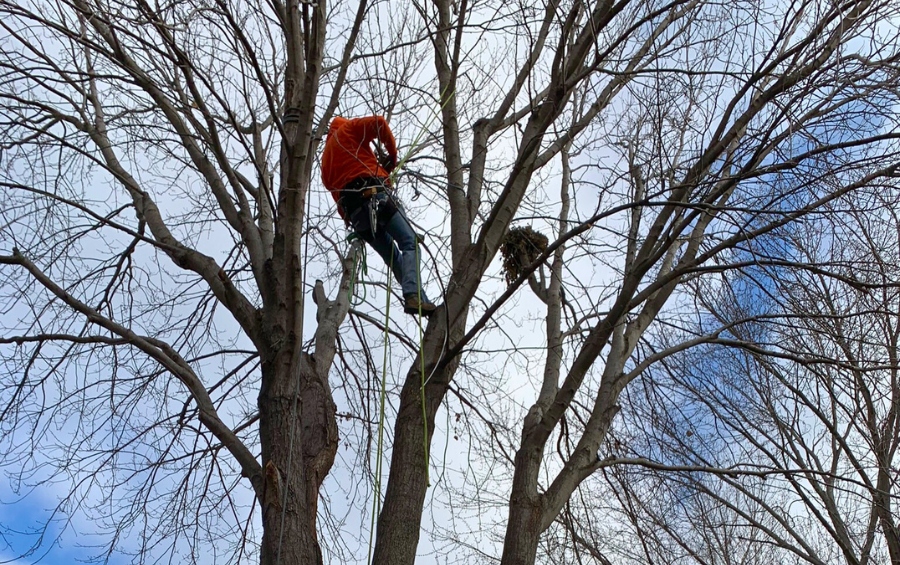
Why Professional Pruning Matters More Than You Think
While minor pruning of small ornamental trees can sometimes be managed by homeowners, protecting valuable trees like mature oaks, maples, and elms requires professional expertise. ISA Certified Arborists identify dozens of factors invisible to untrained eyes:
- Proper Cut Placement: Identifying branch collars for optimal wound closure. Cutting too close removes natural healing tissue; cutting too far leaves decay-prone stubs.
- Hidden Disease and Pest Damage: Spotting canker disease symptoms, insect boring evidence, and internal decay that compromise tree structure.
- Structural Load Assessment: Calculating weight loads for branches over structures and predicting failure risk based on Kansas City storm patterns.
- Species Identification: Distinguishing red oak from white oak groups and elm varieties that require strict winter-only timing for disease prevention.
Expert Insight: “Winter is the best time to prune most trees in Kansas City. Dormancy lets us see the tree’s structure clearly and make precise cuts that encourage strong growth. For oaks and elms, winter is the only safe window when the beetles that spread oak wilt and Dutch elm disease aren’t active. A good winter prune sets your tree up for a healthier, stronger season ahead.” – Stephen Carlson, Director of Sales at Arbor Masters
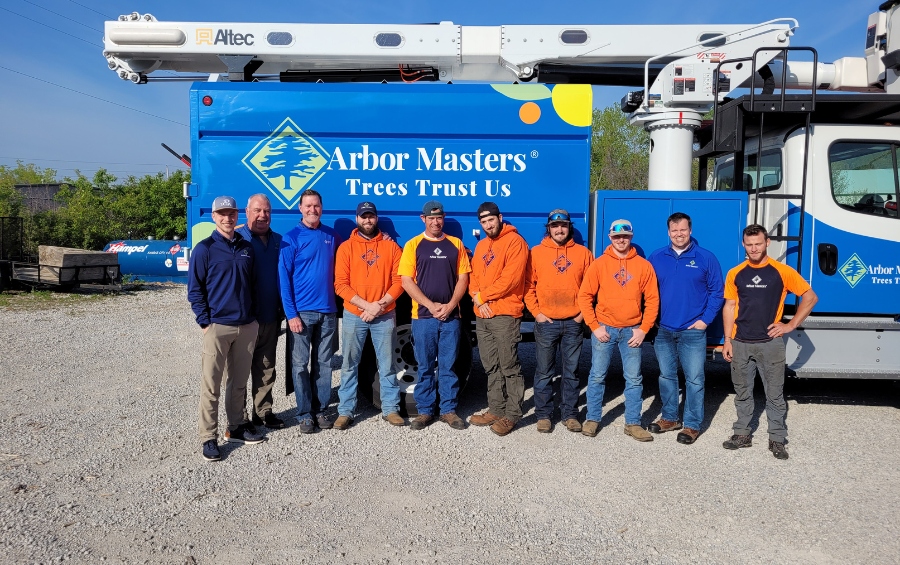
Frequently Asked Questions About Winter Tree Pruning in Kansas City
How do I know if my tree needs pruning this winter?
Look for these signs indicating Johnson County trees need winter pruning:
- Dead branches visible as gray, brittle wood without flexibility
- Crossing or rubbing branches creating disease entry wounds
- Branches hanging low over driveways or roofs
- Storm damage from recent severe weather events
- Mature oaks, maples, or elms not pruned in 3-5 years
- Narrow V-shaped branch attachments prone to splitting
An ISA Certified Arborist inspection can identify structural issues before they become hazards.
How long does it take for trees to recover after winter pruning in Kansas City?
Trees pruned in winter start healing right away, even if you don’t see it until spring. Small to medium cuts usually close within one growing season, while larger wounds on mature trees may take 2-3 years. Still, overall tree health and structure improve immediately, with vigorous new growth visible by spring.
Will winter pruning make my trees more susceptible to cold damage in Johnson County?
No, winter pruning won’t make your trees more susceptible to cold damage. When done by an ISA Certified Arborist, winter pruning doesn’t increase cold damage risk. Trees are already hardened for winter, and dormant tissue is protected. Remember, pruning weak or damaged branches reduces storm breakage. The key is timing; stick to deep dormancy (December–early March), not fall or late spring.
Does winter pruning affect my tree’s spring flowering or bud development in Kansas?
No, winter pruning won’t affect your tree’s spring flowering or bud development. Winter pruning actually encourages stronger spring growth in Johnson County trees. Dormant cuts redirect stored energy to remaining limbs, producing fuller canopies and vigorous new shoots. The only exception is spring-flowering ornamentals, since buds form the prior fall; these are pruned right after bloom.
How often should trees be pruned?
Pruning frequency largely depends on tree age and species:
- Young Trees (first 15 years): Every 2-3 years for structural development.
- Mature Trees (15-50 years): Every 3-5 years for deadwood, damage, and clearance.
- Heritage Trees (50+ years): Every 3-7 years depending on species and condition.
- Fast-Growing Species (silver maples, willows): More frequent attention needed.
- Trees Near Structures: More frequent inspection and maintenance.
Regular winter pruning on a planned schedule prevents hazard accumulation and maintains tree health better than reactive-only pruning.
Schedule Winter Pruning for Your Johnson County Trees With Arbor Masters
Winter provides the optimal pruning window for protecting your Johnson County trees’ health, preventing disease transmission, and protecting your property from storm damage. The science of dormancy, the disease prevention timing for oaks and elms, and the structural benefits of winter work all converge to make December through early March the single best investment in your landscape.
Take advantage of winter scheduling availability before spring demand fills our calendar. Call Arbor Masters today at 913-441-8888 or request your free estimate online. Let us show you why thousands of Johnson County homeowners trust us to protect their most valuable trees through expert winter pruning.

Get the latest local news, tree care tips, special offers, and company updates directly to your inbox! It's easy to subscribe and there's no spam - we promise.
"*" indicates required fields



